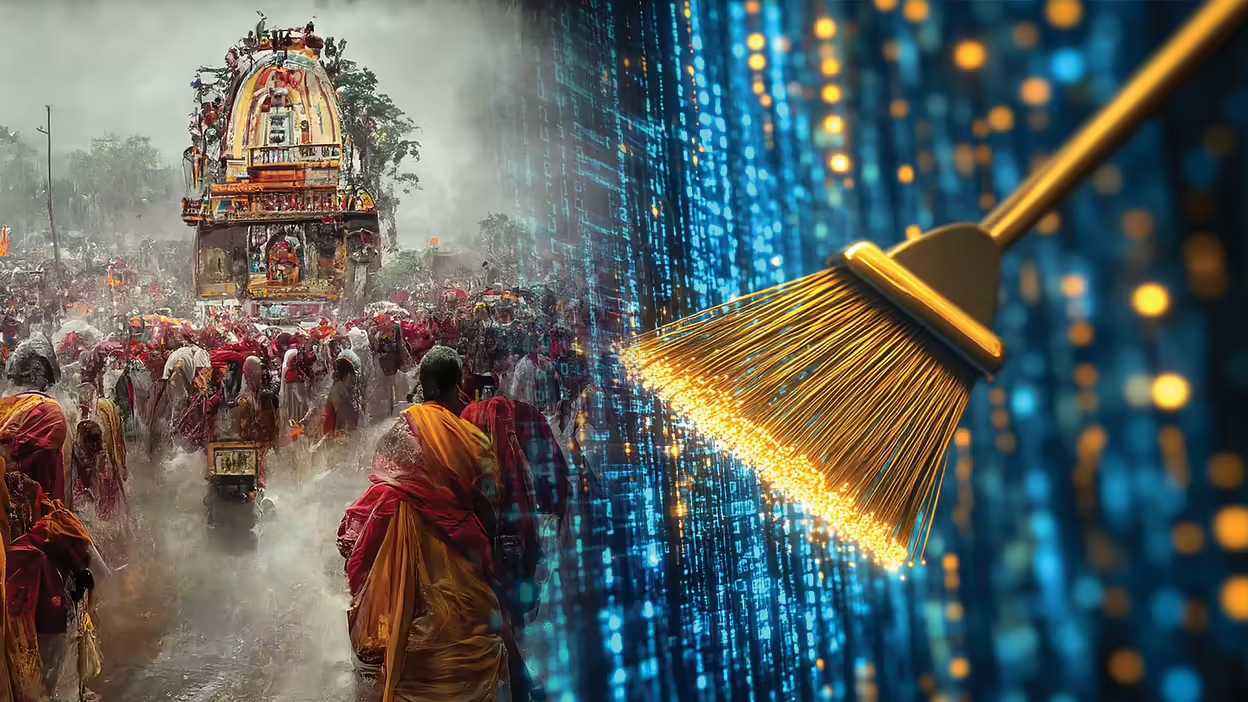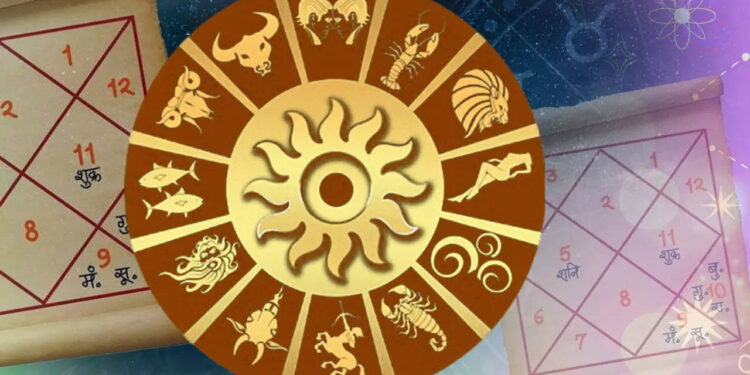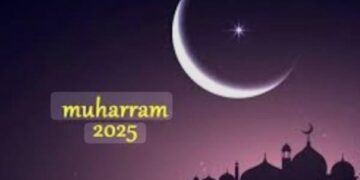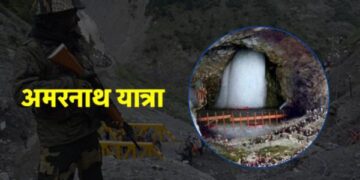Odisha’s world famous Jagannath Rath Yatra starts from today. This tradition, which lasts for about 9 days, is the holy festival of faith, faith and devotion of India, which has been in a legacy for centuries among us. This is the festival when God is among his devotees and during this time neither the king nor the rake. Its biggest feature is that before the commencement of the Rath Yatra of Jagannath Mahaprabhu, the kings of Puri, also called Gajapati, arrive in plain clothes and clean the chariot and chariot path with a gold -handed broom.
This process and method of cleaning the road with a broom of gold -handed broom with gold -handed broom is known as ‘Chhera Pahar’. Actually gold is a sacred metal, which is considered to be the form of Lakshmi and the broom is also called the form of Goddess Lakshmi. The broom is a symbol of positive energy, which not only dirt, but also removes negativity. The path of the three chariots is cleaned with a gold broom before the journey starts and Vedic mantras are also pronounced. This is not only a symbol of spiritual purity, but also expresses the feeling that there should be no shortage in the reception of God. This ritual increases the flow of positive energy. The descendants of the kings of Puri have been using this broom.
The king plays the traditional process. It is a matter of tradition, but what is the history of the king and royal family of Puri? According to traditions, the present king of Puri is ‘Gajapati Maharaja Divya Singh Deb Yadav’. He is the first servant of Lord Jagannath and people consider him an incarnation of Lord Shri Jagannath. Gajapati Maharaja Divya Singh Deb Yadav Ji serves Lord Jagannath by placing a gold broom before the Rath Yatra. He is currently the king of Puri and is also playing the traditional role of the chairman of the temple committee.
When will Jagannath Rath Yatra start? Know the mythological significance of this journey
What is the history of the present king of Puri? King Divy Singh Dev of Puri is the present head of the Bhoi dynasty and he is also known as Gajapati Maharaj Divyasinh Dev IV. His dynasty is a descendant of the hereditary rulers of the Bhoi dynasty, the ancient trialing region (Kalinga, Utkal, South Kosala). This is the same Kalinga that is famous in history for war with Emperor Ashoka and Emperor Ashoka became indifferent after the death of millions of people in this war.
The dynasty of Gajapati Maharaj Divya Singh Dev, who sits on the throne at the age of 17, is the Bhoi dynasty, but the history of the Gajapati title is associated with the eastern Ganga dynasty and has been connected to the Sri Jagannath Temple since the 12th century. This dynasty ruled in the “Utkal” region (present Odisha). Divy Singh Dev Gajapati is the son of Maharaja Birkishore Dev and sat on the throne at the age of 17 after his father’s death in 1970. The Maharaja temple of Puri is the chairman of the management committee, which was formed under the Sri Jagannath Temple Act of 1955. Advertisement
Where did the title of Srigajapati came from, as stated earlier that Gajapati is the title to be held by the king of Puri in Odisha. To find out the beginning of this title, we reach the 12th century with the help of history. In fact, the Gajapati dynasty or governance institution was established by the rulers of the eastern Ganga dynasty. Later dynasties also used this title. It has also been a special thing that the main religious works of these dynasties have included the security of the Jagannath temple, as well as accepted as the patron of the state as the god of the Odia cultural region.
But, this is the history of holding the title of ‘Gajapati’ only. The history of the rulers of the Eastern Ganga dynasty is different and it extends to Andhra Pradesh as a state expansion. It is recorded in history that the four ruling dynasties of the Odisha region have ruled the organization of the Gajapati dynasty and they were all called Gajapati and since then this title has come into vogue.
The history of Eastern Ganga rulers is originally recorded in ancient history, the rulers of Kalinga, Utkal and South Kosala used several royal titles with conquests over the southern regions, including the titles of Kalingadhipati and Trichingadhipati mainly. Among the eastern Ganga rulers, a famous and important name is Anantavarman Vajrahast V (1038 to 1078 AD), who held the titles of Tricklingadhipati (lord of three Kalingas) and Sakalkalingadhipati (lord of the entire Kalinga). In this way he challenged the rights of his contemporary Somvanshi. Somvanshi had the right in Central and Western regions. Advertisement
When was the Gajapati institution established? After him Rajaraja Devendravarman took over the rule, also known as Rajaraja Dev I, who ruled for a short time in 1078 AD and by this time he was facing the same struggles that continued during his predecessor Vajrahast V. This is followed by the name of Anantavarman Chodungang (1078-1147), who
Mbe successfully ruled for a long time and his biggest achievement in history is that he succeeded in integrating Odia states during his reign and from here he laid the foundation of the East Ganga dynasty. Anangabhim Dev III became the next ruler in this eastern Ganga dynasty. He laid the foundation of the Gajapati institution and established Lord Jagannath as the patron deity of the state. Who was the last ruler of the Eastern Ganga dynasty? The descendants were the first ruler to use the title of Gajapati among the Odisha rulers in the Kapilasha temple inscription in 1246 AD. In this way, the Gajapati rulers considered themselves a devotee of Lord Jagannath and accepted their Vaishnavism as religion and became their patron. In the Sanatan tradition, the king is considered a representative of the deity, Ranjan (follows) is the king. Therefore, the Gajapati rulers dedicated themselves to God and started running the kingdom under their protection. The name of Bhanu Dev IV as the last ruler of the eastern Ganga dynasty comes, who ruled till 1434 AD.
When did the Bhoi dynasty emerge? After this, the rule of the Eastern Ganga dynasty was also somewhat unstable. Kapilendra Dev’s coronation took place in 1434 AD, but indicates that the government did not move forward. After this, Suryavansh ruled in 1541. It was from here that the Bhoi dynasty emerged. This dynasty gave a new direction to the political, cultural and religious traditions of Odisha, especially after the fall of the Gajapati Empire. The Bhoi dynasty has ruled from the 16th century to the modern period, but in such a long period, this dynasty has also seen the establishment and restoration. This is the reason that even today its impact remains on the social structure of Odisha.
Who founded the Bhoi dynasty? The Bhoi dynasty was founded by Govinda Vidyadhar (1541 AD). He was the Prime Minister of the then Gajapati King Prataparudra Dev. After the death of Prataparudra Dev in 1540 AD, the Gajapati Empire began to struggle with political instability, then Govinda Vidyadhar took over the reins of the rule and from here the political chapter of the Bhoi dynasty began. However, it is recorded that Govind Vidyadhar was from a Brahmin dynasty, but due to his Prime Minister and administrative skills, he had taken full authority over military power, so he soon established himself as a powerful ruler and also achieved stability, but his tenure was limited to six years. Advertisement
… But the dynasty collapsed soon. In the post -generation after Govind Vidyadhar, his son Chakradhar and then Raghunath Vidyadhar also took over the throne, but he could not establish stability. The reason behind this was the influence of the erstwhile Gajapati dynasty, which other rulers of the Bhoi dynasty failed to compete. The conflict lasted for a long time and the result was that by the end of the 16th century, the intervention of Muslim invaders and Afghans from Bengal made Odisha’s political situation more difficult. Therefore, the power of the Bhoi dynasty became constantly weakened and in 1560 AD the collapse of the first Bhoi dynasty was also recorded. Then how the Bhoi dynasty changed history but … the story does not end here, the Bhoi dynasty was to come to power amidst a complex historical turn and this dynasty came again in prominence and remained at the center of power. There is an important name in the history of Bhoi dynasty – Chakravarti Mukund Dev. Although he is traditionally not considered to be of Govinda Vidyadhar dynasty, he is sometimes called the Chalukya dynasty. There are also some historical contradictory arguments about this. It is also said that he ruled in the name of Bhoi dynasty for the next 8 years i.e. from 1560 to 1568. Advertisement
However, he could not handle the Afghan attacks and in 1568 Mukund Dev was defeated by the Afghan ruler of Bengal, Suleman Karrani. After this defeat, Odisha remained under Mughal rule for some time. However, shortly thereafter, Gajapati Ramchandra Dev I (1568–1607), popularly called Abhinav Indradyumna, established the Nava Bhoi dynasty in Khurda, Odisha. It is also called the Bhoi dynasty of Khurda. In this way Ramchandra Dev I maintained his position as the center of religious and cultural influence. This place was – Purushottam region (Puri). Like the Gajapati kings, he declared himself a “subordinate servant of Jagannath” and took charge of the Jagannath temple in Puri. This is the reason that the descendants of the Bhoi dynasty are honored as the Gajapati Maharaj of Puri from the late 16th century till today.
Gajapati Ramchandra Dev Who was the first? It is also recorded that after the death of Mukund Dev, he tied up with the Mughal Emperor Akbar, resulting in the recognition of ‘Gajapati’. The Madal register of the Jagannath temple also connects him to the Yadu dynasty of Mahabharata. Gajapati Ramchandra Dev was also a Sanskrit poet and scholar who composed the famous drama “Srikrishnabhaktavchalya Charitam”. Under his influence, he stopped the temple demolition campaign of the then fierce invading Kalapahar outside Puri, along with the title of “Thakur Raja” as a honor for the renovation of Hindu temples damaged by the invasion of Kalapahar. His royal title was “Veer Shri Gajapati Veeradhi Veeravar Pratapi Ramchandra Dev”.
Gajapati Maharaj of Puri, although not politically powerful, was religiously and culturally had an important influence. Gajapati Maharaj’s traditional contribution in grand festivals like Rath Yatra continues even today. His role became a symbol of religious-cultural unity among the people of Odisha. This dynasty kept religious tolerance and folk traditions alive in Odisha, coordinating Shaiva, Vaishnava and Shakta traditions.
Bhoi ruled the Khurda kingdom till 1804 AD. The Puri princely state was established during the British rule in 1809 and the descendants of the Bhoi dynasty were formally recognized as the Gajapati king of Puri during the British rule. The British government maintained his religious and cultural status, but political rights were almost abolished. Even today, Gajapati Maharaj is considered as the prominent religious representative of Puri. His name is now taken as “Sri Sri Gajapati Maharaj” and he is considered a symbol of Odia culture associated with Lord Jagannath.






